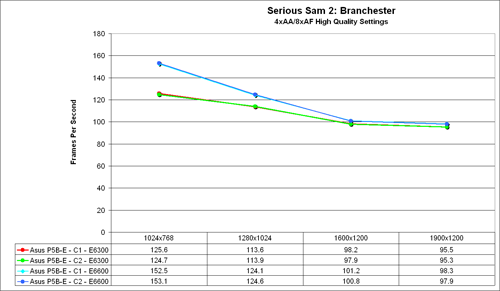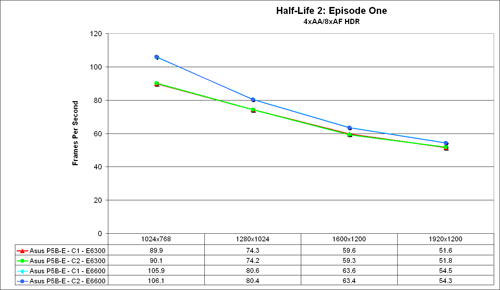ASUS P5B-E: P965 stepping C1 versus C2, Round One
by Gary Key on October 4, 2006 9:00 AM EST- Posted in
- CPUs
Gaming Performance
As usual, gaming performance was tested with a variety of current games. Our review is based on the performance capability of each stepping so we are also including the 1024x768 resolution that is not typically bound by GPU performance in our game benchmarks. We also ran benchmarks with our standard 1280x1024 resolution with 4x antialiasing and with 8x anisotropic filtering (if the game has support) enabled. Given the number of users that run 19 inch LCDs these days, 1280x1024 represents one of the most commonly used resolutions. We decided to also stress the graphics subsystem since we are benchmark testing the overall system capability to compare the performance between the C1 and C2 stepping. In order to do this we were particularly interested in increasing the resolutions and graphic settings so we are including 1600x1200 4xAA/8xAF and 1920x1200 4xAA/8XAF resolutions to see if there are any noticeable differences between the boards when stressed.
Battlefield 2
This benchmark is performed using DICE's built-in demo playback functionality with additional capture capabilities designed in house. When using the built-in demo playback features of BF2, frames rendered during the loading screen are counted in the benchmark. In order to get a real idea of performance, we use the instantaneous frame time and frames per second data generated from our benchmark run. We discard the data collected during the loading screen and calculate a result that represents actual game play. While DICE maintains that results over 100fps aren't always reliable, our methods have allowed us to get useful data from high performing systems.
During the benchmark, the camera switches between players and vehicles in order to capture the most action possible. There is a significant amount of smoke, explosions, and vehicle usage as this a very GPU intensive Battlefield 2 benchmark. We run Battlefield 2 using the highest quality graphics settings available in the video settings. The game itself is best experienced with average in-game frame rates of 35 and up.
Serious Sam 2
This benchmark is performed using Croteam's built-in demo capability in the Serious Sam II engine. We utilize the included Branchester Demo and capture the playback results using the Ctrl-~ function. The benchmark features a large number of combatants, explosions, and general mayhem. The benchmark is primarily GPU sensitive with the actual percentage of GPU/CPU/Audio activity being displayed during the benchmark run. We typically find this game is very playable at average in-game rates of 60 and above. We maximize all settings except antialiasing and anisotropic filtering within the general and advanced video settings.
Half Life 2: Episode One
The Half Life 2: Lost Coast level demonstration first introduced Valve's HDR technology. While certain developers have implemented HDR, there have been several issues with antialiasing (even on ATI cards) being an option. Valve placed a high value on building an HDR implementation that everyone can use with whatever AA/AF settings they want to select. As Lost Coast is essentially a technology demo rather than a full game, we have switched over to Episode One for Source engine performance testing.
We use the built-in timedemo feature to benchmark the game. Our timedemo consists of a protracted battle with a Combine Gunship that takes place in a building, with the walls and ceiling falling apart from all the explosions. The Source engine timedemo feature is similar to the nettimedemo of Id's Doom 3 engine, in that it plays back more than just the graphics. The highest visual quality settings possible were used with HDR turned on. While the Source engine is notorious for giving great frame rates for almost any hardware setup, we find the game isn't as enjoyable if it isn't running at 35fps or above.
Overall in our first series of game benchmarks we find the performance between the C1 and C2 stepping motherboards to be a toss-up. These results are not really surprising based on our previous testing and just goes to show the chipsets are for all purposes are equal in performance. In all three games we see the E6600 outscoring the E6300 by up to 21% at the lower resolutions with the performance gap closing rapidly as the games become more GPU limited at the higher resolutions.
As usual, gaming performance was tested with a variety of current games. Our review is based on the performance capability of each stepping so we are also including the 1024x768 resolution that is not typically bound by GPU performance in our game benchmarks. We also ran benchmarks with our standard 1280x1024 resolution with 4x antialiasing and with 8x anisotropic filtering (if the game has support) enabled. Given the number of users that run 19 inch LCDs these days, 1280x1024 represents one of the most commonly used resolutions. We decided to also stress the graphics subsystem since we are benchmark testing the overall system capability to compare the performance between the C1 and C2 stepping. In order to do this we were particularly interested in increasing the resolutions and graphic settings so we are including 1600x1200 4xAA/8xAF and 1920x1200 4xAA/8XAF resolutions to see if there are any noticeable differences between the boards when stressed.
Battlefield 2
This benchmark is performed using DICE's built-in demo playback functionality with additional capture capabilities designed in house. When using the built-in demo playback features of BF2, frames rendered during the loading screen are counted in the benchmark. In order to get a real idea of performance, we use the instantaneous frame time and frames per second data generated from our benchmark run. We discard the data collected during the loading screen and calculate a result that represents actual game play. While DICE maintains that results over 100fps aren't always reliable, our methods have allowed us to get useful data from high performing systems.
During the benchmark, the camera switches between players and vehicles in order to capture the most action possible. There is a significant amount of smoke, explosions, and vehicle usage as this a very GPU intensive Battlefield 2 benchmark. We run Battlefield 2 using the highest quality graphics settings available in the video settings. The game itself is best experienced with average in-game frame rates of 35 and up.
 |
| Click to enlarge |
Serious Sam 2
This benchmark is performed using Croteam's built-in demo capability in the Serious Sam II engine. We utilize the included Branchester Demo and capture the playback results using the Ctrl-~ function. The benchmark features a large number of combatants, explosions, and general mayhem. The benchmark is primarily GPU sensitive with the actual percentage of GPU/CPU/Audio activity being displayed during the benchmark run. We typically find this game is very playable at average in-game rates of 60 and above. We maximize all settings except antialiasing and anisotropic filtering within the general and advanced video settings.
 |
| Click to enlarge |
Half Life 2: Episode One
The Half Life 2: Lost Coast level demonstration first introduced Valve's HDR technology. While certain developers have implemented HDR, there have been several issues with antialiasing (even on ATI cards) being an option. Valve placed a high value on building an HDR implementation that everyone can use with whatever AA/AF settings they want to select. As Lost Coast is essentially a technology demo rather than a full game, we have switched over to Episode One for Source engine performance testing.
We use the built-in timedemo feature to benchmark the game. Our timedemo consists of a protracted battle with a Combine Gunship that takes place in a building, with the walls and ceiling falling apart from all the explosions. The Source engine timedemo feature is similar to the nettimedemo of Id's Doom 3 engine, in that it plays back more than just the graphics. The highest visual quality settings possible were used with HDR turned on. While the Source engine is notorious for giving great frame rates for almost any hardware setup, we find the game isn't as enjoyable if it isn't running at 35fps or above.
 |
| Click to enlarge |
Overall in our first series of game benchmarks we find the performance between the C1 and C2 stepping motherboards to be a toss-up. These results are not really surprising based on our previous testing and just goes to show the chipsets are for all purposes are equal in performance. In all three games we see the E6600 outscoring the E6300 by up to 21% at the lower resolutions with the performance gap closing rapidly as the games become more GPU limited at the higher resolutions.










27 Comments
View All Comments
cmdrdredd - Wednesday, October 4, 2006 - link
How come they talk about using 1.5125 vcore and then CPU-Z says it's only 1.26. Are they running at 1.5125 as they said or not?I don't know many people who can get a E6300 to 3.6 wih that type of low voltage.
Gary Key - Wednesday, October 4, 2006 - link
CPU-Z does not report the voltages correctly on the Core 2 Duo processor series.cmdrdredd - Wednesday, October 4, 2006 - link
It sure works fine for me when I downloaded it off the site. I guess it's a newer version.On your past articles that showed voltages they also read low which may mean it wasn't reading at all.
Gary Key - Thursday, October 5, 2006 - link
The article was already completed when 1.37 came out. I have tested it the past couple of days and notice the voltage is reading a tad bit high on some boards now. However, it is a lot more accurate than 1.36 or before. At least it will be easy to tell from the screenshots what range our voltage settings are at now.vailr - Wednesday, October 4, 2006 - link
There's an updated CPU-Z "version 1.37" available.vailr - Wednesday, October 4, 2006 - link
http://www.majorgeeks.com/CPU-Z_d425.html"> CPU-Z 1.37LoneWolf15 - Wednesday, October 4, 2006 - link
Does the P5B-E support Matrix RAID?Capt Caveman - Wednesday, October 4, 2006 - link
Yes, it will support Matrix RAID as it uses a ICH8R Southbridge.LoneWolf15 - Wednesday, October 4, 2006 - link
Every time I've looked for one, it didn't have the slot configuration I needed, or lacked Firewire...this looks like it might have everything.My only question left...I've not heard great things about the JMicron IDE controller used since the i965 no longer has ATA support. I'll still need it, what with the lack of good SATA optical drives, and some programs that appear not to like SATA optical drives even if I used them. What does Anandtech think of this controller as opposed to the native Intel ICH7xx IDE controller?
xsilver - Wednesday, October 4, 2006 - link
just wanted to clarify,485fsb was the highest you could get the board to go under default voltage (cpu+ram?) conditions?
do you think that was a mobo limitation or cpu?